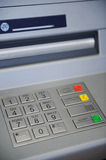|
ATM Skimming Scheme
Automated Teller Machine or ATM skimming is a fraud scheme to steal personal information from innocent ATM users and empty their bank accounts. A cash machine skimmer is a piece of equipment which is installed by scammers on the cash machine or wherever cards are swiped like gas stations to read a cardholder’s electronic account information stored on the magnetic stripe on the back of the card when the card is inserted into the skimming device. Depending on the advanced feature of the ATM skimmer device and scheme, the Personal Identification Number (PIN) can also be read by the machine when the numbers are entered by the cardholder or if the skimmer lacks such technical sophistication, scammers also install a camera nearby to videotape the PIN as it is being punched into the keypad. As you may have guessed by now, ATM skimming is illegal and combined with the associated card PIN can be a nightmare for banking customers who can lose all their account balances to the last penny. Most often, the installed ATM skimming device is not immediately noticeable by the credit card users and the best way to detect them is through 24 hours surveillance by the banks to detect their installation. If a skimmer is installed without being detected while it is being installed, it might just give the scammers the time they need to empty a few bank accounts before the banks notice the fraud scheme. Also, less sophisticated schemes may resort to social engineering to extract the PIN information from the unsuspecting customers to complete their fraud scheme. For example, while the skimmer device reads and stores the card information, a person approaches the cardholder to offer help with system access since the cash machine does not work due to the ATM skimmer. Here are a few precautions in order to avoid getting caught in a skimming scam: Avoid using ATMs from non-bank locations such as liquor stores. Bank locations offer better security through security guards and camera surveillance during business and non-business hours. Avoid displaying your PIN as you type it on the ATM keypad. Hide your fingers as you type the code. If the system malfunctions, stop entering the code multiple times as a camera might be recording your repeated movement. Reject a stranger’s offer to help you with code entry and system access. Also, pay attention to shoulder surfing by people standing too close behind you. If you get suspicious that someone might be trying hard to see your numbers as you type them, stop your activities and consider waiting for a while or using another ATM. Beware of portable skimmer devices. It is important to know that portable skimming devices are also used in the restaurants, gas stations and other public places where credit cards are commonly used to create counterfeit credit cards. Although it is very hard to know which restaurant worker might be abusing a customer’s credit card, the best protection against portable skimming device is to pay with cash. Don't accept help from non-bank employees. As mentioned, you may be approached by some individuals who offer to help you if you share your card PIN. This is a typical scam since the machine doesn't work because of the skimming device and scammers wait until the cardholder fails accessing the account a few times before offering help. Once they collect the PIN and the card information, they take the skimming device and walk away after telling the card user to come back later when the system is operational. Notify the bank. If you are unable to access the cash machine and you are approached by a stranger who offers help, reject the help and notify the bank personnel immediately. Replace your cards. If you suspect that you might have been a victim of skimmming, ask the bank to replace your cards with new ones immediately. Monitor your account. It is also prudent to closely monitor your accounts for a while if you suspect wrongdoing. Return to home page from "ATM Skimming". |